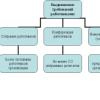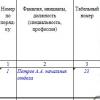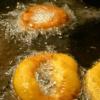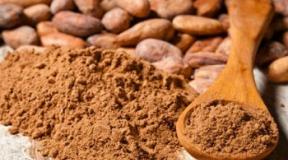Rapid test for streptococcus a. Test for determining sore throat Streptatest - “Streptatest for detecting group A streptococcus saved my son from the third course of antibiotics! Differential diagnosis of scarlet fever
Instructions for use
Streptotest rapid test for the diagnosis of β-hemolytic streptococcus group a n5 instructions for use
Compound
1.5 aluminum foil sachets with test strips, desiccant sachet.
2.5 CE marked swabs.
3.5 extraction tubes.
4.5 language holders with CE marking.
5.Jar with extracting reagent A (sodium nitrite 2M), 10 ml.
6.Jar with extracting reagent B (acetic acid 0.4M), 10 ml.
7. Annotation.
Description
Streptotest is a universal express test for a doctor and a patient, which allows diagnosing the presence or absence of a dangerous beta-hemolytic group A streptococcus in the throat within 5 minutes. the most important thing is to prevent the development of severe complications!
Streptatest is a sandwich membrane immunochromatographic test.
Streptotest rapid test for the diagnosis of group A beta-hemolytic streptococcus No. 5
Selling features
No license
Special conditions
Do not use after the expiration date.
Do not replace reagent bottle caps. Samples can be contaminated with infectious agents. Material in direct contact with samples is considered contaminated. Follow the instructions, taking precautions.
Indications
With inflammation of the mucous membrane and lymphoid tissue of the pharynx.
If you suspect a sore throat, pharyngitis, scarlet fever.
- You can buy the Streptatest rapid test for the diagnosis of b-hemolytic streptococcus group a n5 in Moscow at a pharmacy convenient for you by placing an order on the website.
- We have low price for the Streptatest rapid test for the diagnosis of β-hemolytic streptococcus group a n5 in Moscow.
You can see the nearest delivery points in Moscow.
Mode of application
Dosage
1.Preparation of the reagent (drip 4 drops from the red bottle into the extraction tube).2. Preparation of the reagent (drip 4 drops from the yellow bottle into the extraction bottle).
3. Taking the material (take a swab from the surface of the tonsils and the back of the pharynx without touching the gums, tongue, palate).
4. Place the swab with the material in the test tube, twist 10 times and leave for 1 minute.
5. Squeeze the cotton swab into the solution.
6. Immerse the test strip with the arrows down in the solution for 5 minutes and read the results.
Express test at home:
on streptococcus.
Streptococcus is a genus of gram-positive anaerobic bacteria that lives in the respiratory and digestive tract, and especially in the mouth and nose of humans.
It is he - streptococcus - that is common reason occurrence. This bacterium lives on household items, skin and mucous membranes, as well as in the digestive tract.
Getting into the throat with air or poorly processed food, streptococcus begins to destroy healthy cells, which leads to the formation of purulent processes. Streptococcus is especially active against the background of reduced immunity.
This bacterium causes diseases such as scarlet fever, pharyngitis, tonsillitis (angina).
Pharyngitis is characterized by a moderate increase in temperature, sore throat and sore throat, as well as a dry and sometimes painful cough. With angina, there is an increase in the tonsils, the formation of purulent foci and an increase in body temperature to high levels. Scarlet fever manifests itself in the same symptoms as sore throat, plus specific grains on the tongue and a rash on the body are also added to them.
In any case, an accurate diagnosis can only be made by a doctor after a complete examination. However, in order to accurately determine the diagnosis and not miss streptococcal sore throat on early stages, you can do an express test for streptococcus yourself at home. And already with the test results, consult a doctor.
First, it will save you time and money by eliminating the need to stand in lines at the clinic and spend money on drugs you do not need.
Secondly, according to the test results, the doctor will be able to make an accurate diagnosis and prescribe the appropriate treatment with exactly those drugs that are needed in this case.
"RED streptococcus A" - rapid test for streptococcus.
V medical institutions to diagnose beta-hemolytic streptococcus A, bacteriological research is also used. The only drawback of such an examination in a medical institution is the expectation of the result, which can take several days.
Therefore, in order not to waste time and illness, treatment has to be prescribed here and now, without waiting for the results.
"RED streptococcus A" allows you to confirm or exclude within 10 minutes streptococcal infection... And in case of a negative result, avoid unnecessary use of antibiotics.
Rapid test for streptococcus. How to use?
The rapid streptococcus test is easy to use. The sensitivity of the test is over 99%.
This test kit includes:
- test strips in white plastic cassettes;
- a dropper bottle containing reagent pink A;
- a bottle with a dropper cap containing colorless reagent B;
- disposable plastic test tube;
- sterile cotton swabs on the probe;
- disposable pipettes;
- adhesive labels for records;
- instructions for use.
Analysis.
- Add 5 drops of pink reagent A and 5 drops of colorless reagent B to a disposable plastic tube. The solution should turn pale yellow.
- Using a sterile cotton swab, swab the tonsils and / or the back of the larynx, avoiding contact with the teeth, gums, tongue and cheeks.
- Place the swab with the sample in the test tube. In order to wash off the sample, the swab must be rotated along the walls of the tube 10 times clockwise and 10 times counterclockwise. Squeeze out the remaining liquid from the swab by pressing it against the walls of the tube. Discard the tampon.
- Immediately before starting the analysis, open the package of the RED Streptococcus A test and put it on a dry, flat, horizontal surface.
- Using a disposable plastic pipette, add 4 drops of liquid sample into the round window of the cassette marked with the letter S.
- After 10 minutes, visually assess the result of the reaction.


Interpretation of results.
- One BLUE control line in the cassette test window indicates a negative test result. That is, one blue line indicates the absence of group A streptococci cells in the analyzed sample.
- The detection of two parallel colored lines (BLUE and RED) in the test window of the cassette indicates a positive result of the analysis, i.e. two bands in the test indicate the presence of group A streptococcus cells in the analyzed sample. The intensity of the red analytical line in the test window may vary depending on the concentration of group A streptococcus cells in the sample.
- If no lines appear in the test window of the cassette or only a red analytical line is formed, the result is considered invalid. If this result, the analysis should be repeated using another test for streptococcus.

Note!
A separate tube, a separate pipette and a separate Streptococcus test must be used for each sample. Do not use tests after the expiration date. Disposable medical gloves should be worn when testing. Used tests and residues biological material must be placed in a special container for sanitary waste.
The last updated description by the manufacturer 13.09.2019
Filtered list
Pharmacological group
Nosological classification (ICD-10)
Compound
Appointment
Group A β-hemolytic streptococcus is one of the main causative agents of upper respiratory tract, especially sore throats, pharyngitis and scarlet fever (10 to 20% of sore throats in adults and 20 to 40% of sore throats in children are caused by group A β-hemolytic streptococcus). It is important to differentiate infections caused by group A streptococcus from other types of infections (eg, viral) in order to prescribe the necessary therapy.
Preliminary diagnosis and treatment of infections caused by group A streptococcus reduced the severity of symptoms and the number of complications such as glomerulonephritis and acute articular rheumatism.
It takes 24 to 48 hours to identify and identify the pathogen using traditional methods.
The method of immunochromatography allows you to directly detect the specific antigen of group A streptococcus with a single smear, which, in turn, allows the doctor to immediately diagnose and prescribe the necessary course of treatment.
Equipment
1.20, 5 or 2 pack. aluminum foil with test strips, desiccant bag.
2. 20, 5 or 2 swabs with CE marking.
3. 20, 5 or 2 extraction tubes.
4. 20, 5 or 2 tongue depressors with CE marking.
5. Jar with extracting reagent A (sodium nitrite 2 M), 10 ml.
6. Jar with extracting reagent B (acetic acid 0.4 M), 10 ml.
7. Annotation.
8. Stand for extraction tubes *.
9. Control positive sample of group A streptococcus inactivated, 1 ml **.
10. Control negative sample of group A streptococcus inactivated, 1 ml **.
* Not available in items # 2 and # 5. For sets No. 2 and No. 5, a special hole on the front side of the package is used as a stand for the test tube (you just need to pierce the designated place with a test tube).
** Not available in items # 2 and # 5, available upon request.
Operating principle
STREPTATEST is a sandwich membrane immunochromatographic test.
Antibody to the antigen of group A streptococcus is fixed in the tested area of the membrane. The second antibody to the group A streptococcus antigen combines with the purple latex particles and is placed above the immersion zone of the membrane. Pre-specific antigen of group A streptococcus is extracted from the smear using extraction reagents.
The bottom of the test strip is then dipped into the extraction solution. The specific antigen of group A streptococcus binds to an antibody labeled with latex particles. The mixture moves through the chromatographic system along the membrane, and the complex is fixed in the test zone.
The appearance of a purple band in this area indicates a positive result, while its absence indicates a negative result. The presence of a magenta band in the control zone means that the test was performed correctly. The absence of this band indicates the inadequacy of the test and incorrect analysis.
Analysis procedure
1.Using a tongue holder, press down on the tongue so that saliva does not get on the special tampon. Take a swab from the tonsils, throat and all inflamed, ulcerative or exudative areas.
2. It is recommended that the test be performed immediately after taking a smear. If this cannot be done immediately, swab specimens can be stored for 4 hours at room temperature(15-30 ° C) in a dry, sterile and hermetically sealed container or for 24 hours in a refrigerator (2-8 ° C). If another culture needs to be tested at the same time, a new swab should be used.
3. Immediately before testing, remove the test strip from the bag.
4. Pour 4 drops of pink extraction reagent A into an extraction tube and add 4 drops of colorless extraction reagent B. Shake the tube slightly to mix the two solutions. The mixture will change color from pink to colorless.
5. Dip the swab into the test tube. Twist the swab about 10 times in the extraction solution. Leave it on for 1 min.
6. Squeeze the swab against the side of the tube to remove any excess liquid. Throw away the tampon.
7. Place the test strip in the extraction tube with the arrows pointing towards the extraction solution. Leave the test strip in the vial.
8. After 5 minutes the result can be read.
If the concentration of the pathogen is high, then a positive result may appear in the first minute. However, to be sure of a negative result, you must wait 5 minutes.
Do not take into account the result obtained after 10 minutes.
results
Positive: the control and test zones display two magenta colored bars.
Negative: there is only one magenta bar in the control zone.
Note. If no bands appear in the control and test zones, then the analysis was performed incorrectly. It is necessary to repeat the procedure one more time.
Quality control
Internal control
The control strip is used for internal control of the correct functioning of the test strip and reagents.
External control
1. Pour 4 drops of reagent A and 4 drops of reagent B into an extraction tube. Mix well.
2. Add a drop of the control positive or negative sample to the test tube.
3. Immerse a clean swab in a test tube and perform all test operations as for taking a throat swab. It is recommended that positive and negative control samples be tested each time a new lot of kits is received and when the user changes. Also, if in doubt about the reliability of the tests performed (storage, the testing process itself), it is recommended to check the control samples. If the results of the control tests carried out do not correspond to the declared ones, you should contact the company representatives. Dectra Pharm.
Specifications
1. The quality of the test depends on the quality of the sample taken. A false negative result can be due to a poor sample or improper swab storage. A negative result can also be obtained in patients who are at the initial stage of the disease and have an insufficient concentration of antigens. Therefore, if a group A streptococcus infection is suspected and the test result is negative, a new smear should be taken and tested using conventional culture methods.
2. Use the swabs supplied in the kit.
3. In rare cases, samples with large quantities Staphylococcus aureus can give false positive results. If Clinical signs do not correspond to the test results, it is recommended to carry out a traditional bacteriological examination.
4. Respiratory infections, for example, pharyngitis, can be caused by streptococcus other than serogroup A, as well as other pathogens.
5. STREPTATEST does not allow quantitative assessment of the concentration of group A streptococcus.
6. As with any diagnosis in vitro, clinical diagnosis should be based not only on the test results, but also on the conclusion of a specialist made after all clinical and biological studies.
pharmachologic effect
pharmachologic effect- diagnostic.Precautionary measures
As extraction reagents A and B pose a potential hazard in case of improper use and / or ingestion, consult a doctor immediately.
Close the jars with reagents A and B immediately after use and keep them out of the reach of patients.
Inform patients about possible risks that carry reagents A and B. Do not use after the expiration date. Do not change the lids of the reagent jars (samples may be contaminated with infectious agents).
Material in direct contact with samples is considered contaminated. Instructions must be followed, taking precautions. The product is intended solely for diagnostic purposes. in vitro!
special instructions
As a result of a comparative study conducted with the participation of 525 patients with symptoms of sore throat or pharyngitis, it was found that the sensitivity threshold of the STREPTATEST test varies depending on the study and the strains analyzed. Its range is from 5 · 10 3 bacteria / test to 5 · 10 5 bacteria / test.
STREPTATEST test sensitivity threshold
Accuracy
Int-test accuracy was confirmed on the basis of 15 replications using 3 samples: negative, weakly positive and highly positive. All 3 samples were correctly identified 99% of the time.
Intertest Accuracy was confirmed on the basis of 15 independent studies of 3 samples (negative, weakly positive and highly positive). 3 sets of STREPTATEST were used. All samples were correctly identified 99% of the time.
In most cases, a pediatrician needs to examine the patient to make a correct diagnosis. But in order not to miss the bacteria, the doctor may prescribe additional tests for scarlet fever in children. They are done quickly enough and then you can accurately assign correct treatment and avoid complications.
What kind of disease?
Scarlet fever is a dangerous bacterial infection caused by bacteria of the genus Streptococcus, group A. It used to be very serious and frequent illness in babies, today it is rare. reduced the severity of symptoms and the prevalence of the disease.
The most dangerous are the complications that cause streptococcal toxins. In order to avoid this, it is enough to start treatment on time. Therefore, a correct and timely diagnosis is a guarantee of a positive course of the disease.
Confirmation of scarlet fever
The doctor first does a physical examination of the patient to check for the presence of the disease. During the initial checkup, your child's pediatrician checks the condition of your child's tongue, throat, lymph nodes, and tonsils. The doctor will also examine appearance and the texture of the rash.
If scarlet fever is suspected of your baby, the doctor should send it for tests. This will be a throat swab, as well as a blood test, sometimes doctors insist on passing urine.
The purpose of this diagnosis is not only to establish whether there is a disease or not, but also to find out the severity of the disease and the manifestation of possible complications.
Tonsil and throat swab
Essential for a correct diagnosis. The procedure is very simple. A swab is taken from the throat with a clean spatula or special swab. Then all this is placed in a test tube with a special solution and sent to the laboratory. Next, the contents are placed in a nutrient medium and wait until colonies of bacteria that the crumbs have in the throat grow. This takes several hours.
Thus, it is established whether there is a group A streptococcus among these bacteria, and also determine the sensitivity to certain antibiotics. And this is important for the correct further treatment.
The method is not always accurate, since normally healthy people streptococcus can be detected in the smear, and also if the mother began independent unplanned treatment and used an antibiotic, the result will be negative.
Blood test for scarlet fever
Appointed general analysis blood, which will tell you if there is inflammation in the body and the presence bacterial infection... From a blood test, you can never tell whether there is scarlet fever or not, but the following indicators are observed: shift neutrophilia leukocyte formula to the left, increased ESR, leukocytosis.

Express - test for scarlet fever
There are special rapid tests to detect streptococcus. They are often used by parents of babies, who often have sore throats. This is a homemade method for detecting bacteria.
It is called Streptatest. The instructions indicate that it shows the presence of group A hemolytic streptococcus in the throat, which can be not only with scarlet fever, but also with angina, tonsillitis, pharyngitis.
The test is very quick, you will see the result in five minutes. Take a sample from the throat and tonsils with a special swab, dip it into a special solution, then put the test strip itself there and wait for the result.
In case of detection of a group streptococcus. And we can assume that the child has scarlet fever or streptococcal sore throat. But in any case, the treatment will be with an antibiotic. If the result is negative, this test will help to avoid unnecessary antibiotic use.
The price is quite reasonable, for 5 test strips you will pay approximately 1000 - 1300 rubles.
In any case, you must notify your doctor about the results of your home diagnosis.

Differential diagnosis of scarlet fever
Symptoms of the disease are similar to other childhood infections such as measles, rubella, pseudotuberculosis. Therefore, it is very important to differentiate (separate) all these diseases and correctly diagnose. After all, the treatment of all these infections will be radically different.
For differential diagnosis, all major diseases are taken and compared according to their characteristics. Here is a table comparing the symptoms of scarlet fever, measles, and rubella.

Tests to establish complications with scarlet fever
As we already know, it is not scarlet fever itself that is terrible, but the complications that arise in the body after it. Therefore, if the diagnosis is confirmed and antibiotic therapy is prescribed, the doctor directs for the following tests.
Analysis of urine
A urine test is prescribed to determine if there is such a serious complication as glomerulonephritis. If there is, protein, leukocytes, casts and erythrocytes are found in the urine.
Electrocardiogram
An EKG is used if the doctor suspects myocarditis. And if diffuse myocarditis is assumed, ECHO-cardiography is also prescribed.
Rapid test for the diagnosis of group A streptococcus No. 2








Compound
- 2, 5 or 20 aluminum foil sachets with test strips, desiccant sachet;
- 2, 5 or 20 CE marked swabs
- 2, 5 or 20 extraction tubes;
- 2, 5 or 20 tongue depressors individually wrapped with CE marking;
- Control positive sample of group A streptococcus inactivated -1 ml
; - Control negative sample of group A streptococcus inactivated -1 ml
(not available in sets # 2 and # 5); - A jar with an extracting reagent A (sodium nitrite 2M) -10 ml;
- A jar with an extracting reagent B (acetic acid 0.4 M) -10 ml;
- Annotation;
- Extraction tube holder (not available in sets # 2 and # 5).
Description
It takes 24 to 48 hours to identify and identify the pathogen using traditional methods. But the methods of immunochromatography today make it possible to directly detect the specific antigen of group A streptococcus with the help of one smear, which in turn allows the doctor to immediately diagnose and prescribe the necessary course of treatment.
Precautionary measures
Since extracting reagents A and B pose a potential hazard, in case of improper use and / or contact with the skin, in the eyes, immediately rinse the damaged area with plenty of water, if reagent A is swallowed, provoke vomiting, then drink plenty of fluids; if reagent B is swallowed, rinse out mouth, then drink plenty of fluids.
In all these cases, consult a doctor.
Close the jars of reagents A and B immediately after use, keep them out of the reach of patients.
Do not replace reagent bottle caps.
Samples can be contaminated with infectious agents. Material in direct contact with samples is considered contaminated. Follow the instructions, taking precautions.
For in vitro diagnostic use only! Do not reuse!
Method of administration and dosage
- Use a tongue holder to press down on your tongue to prevent saliva from getting on the special swab. Take a swab from the tonsils, throat, and any inflamed, ulcerative, or exudative areas.
- It is recommended that the test be performed immediately after taking a smear. If this cannot be done immediately, swab samples can be stored for 4 hours at room temperature (15 ° C-30 ° C) in a dry, sterile and hermetically sealed container, or for 24 hours in a refrigerator (2 ° C-8 ° C ). If you need to test another culture at the same time, use a new swab.
- Remove the test strip from the bag immediately before testing.
- Pour 4 drops of pink extraction reagent A into an extraction tube and add 4 drops of colorless extraction reagent B. Shake the tube slightly to mix the two solutions. The mixture will change color from pink to colorless.
- Dip the swab into the tube. Rotate the swab in the extraction solution about 10 times. Leave it on for one minute.
- Squeeze the swab against the side of the tube to remove any excess liquid. Discard the tampon.
- Place the test strip in the extraction tube with the arrows pointing towards the extraction solution. Leave the test strip in the vial.
- After 5 minutes, you can evaluate the result. If the concentration of the pathogen is high, then a positive result may appear in the first minute. However, to be sure of a negative result, you must wait 5 minutes. Do not take into account the result obtained after 10 minutes.
Results:
Positive: Control and test areas display two magenta colored bars
Negative: only one magenta band is displayed in the control zone
Note: if not a single band appears in the control and test zones, then the analysis was performed incorrectly. It is necessary to repeat the procedure again
Best before date
All items included in the kit must be stored at room temperature or in the refrigerator (2 ° C to 30 ° C). Do not freeze.
Do not use the kit beyond the expiration date printed on the package. Expiration date 24 months.
The information presented on the site should not be used for self-diagnosis and treatment and cannot serve as a substitute for an in-person consultation with a doctor.



















